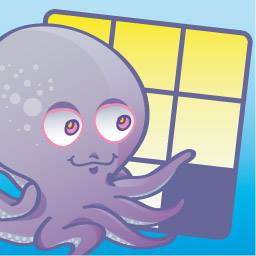When we decided to create our first game Octopuzz (available for iPhone, iPad, and Android devices) we had several goals in mind. As we didn’t have experience on the business part of selling digital games for mobile devices, one of our goals was to create a very simple game, finish it as soon as possible, and learn with it all the tips and tricks of the App Store and Google Play.
But at the same time, we didn’t like the idea of making a new Flappy Birds clone, but to make a game with some pedagogical value. So we decided to create the classic Sliding Puzzle game, reduce its size to 3×3 tiles (an 8-puzzle) and modify the game mechanics to add some educative value.
The pedagogical goal of Octopuzz is the development of problem-solving strategies in the player. More specifically, achieve the intuition of the “divide and conquer” problem-solving strategies by the kid, where a hard problem is reduced to a smaller and simpler problem for which we already know de solution. To achieve this goal, Octopuzz presents puzzles of increased difficulty to the player, beginning with a puzzle with a “one movement” solution, following with another puzzle with a “two movements” solution, and so on, until we reach a limit (a “ten movements” solution puzzle) that we consider hard enough for 10-11 years old kids.
The goals that the player tries to achieve in Octopuzz are very distinct to this one, of course:
- Puzzles allow the development of visual memory and the capacity to understand spacial relationships
- The tiles can only be moved on a very specific way, so the player must learn the existence of game rules and constraints that limit the way he can solve de problem
- Every time a tile is moved, one blue bubble from the left pane disappears, so the player learns that the number of bubbles is very important in this game, something that is reinforced when the puzzle collapses as the last bubble pops
- Every time the player finds the solution to a puzzle, a golden star “comes alive” on the right pane, and the next puzzle is harder to solve; but there is a limited number of golden stars, so the long goal of the kid will transform from “find the solution to this puzzle” to “solve all puzzles, even the most difficult of them”
- Usually, when a new puzzle appears, it can be solved by moving a tile so that the puzzle will be reduced to the puzzle just solved previously, so the kid will practice its capacity to remember sequences
- But sometimes, Octopuzz will present a puzzle that is completely different from the last solved, to push the kid out of its confort zone, forcing the development of global strategies and not only sequence memorization
How can we help our kids to achieve all this pedagogical goals when playing Octopuzz?
First we need to know the problem-solving strategy that is used to solve this kind of puzzles: if we put all the top row and leftmost column tiles in their correct position, we have reduced the problem to another with one row and one column less, because the ordered row and column don’t need to be moved again until we find the solution to the whole puzzle. In Octopuzz this means that we always begin by ordering the top 3 tiles and then the remaining 2 leftmost tiles (or the other way around, beginning with the column). That left us with 3 tiles to order (plus the hole), a very simple problem.
Second, we need to understand that this kind of strategy is hard to explain to a 7-11 years-old kid, because they are not going to understand the kind of abstract thinking that we are going to use in our explanation. But that doesn’t mean that kids this age cannot get the intuition of this strategy, specially from its practice.
So, my educational tips for parents are:
- Share the experience of playing Octopuzz with your kids, make it something funny and an opportunity to share some time with them
- Don’t solve any puzzle for them, even when they ask for it; if you are not able to solve the puzzle, they will think it is a game for “old people”; if your solve it too easily, they will think they are not capable of doing it
- Let the kid discover the game rules, explicit (all tiles must be moved horizontally or vertically into the hole; every time a movement is performed, a blue bubble disappears; the puzzle restarts when there are no more bubbles), or implicit (the number of blue bubbles equals the number of movements to solve the puzzle; every time a golden star lights up, the next puzzle will be more difficult)
- But explain them if the kid ask for them; also give a physical meaning to the rules, like explaining that two tiles cannot be at the same place, or that a tile cannot “move through” another tile
- Let the kid cope with frustration, when he is near completion of a puzzle but there are no more blue bubbles available; explain that the puzzle will be restarted and that he will be able to solve it this time
- Make questions instead of offering solutions; if the kid makes a mistake or asks what movement she should do next, try to make her think about it instead of offering a solution (“why did you moved that tile?”, “What will happen if you move this tile, will you be nearer the solution, or farther?”
The capacity of solving problem is a very important ability in the development of a human being, not only in scientific or technological fields, but in any area. I hope that Octopuzz and this tips will help your kids to develop this capacity.
– Moises Friginal
